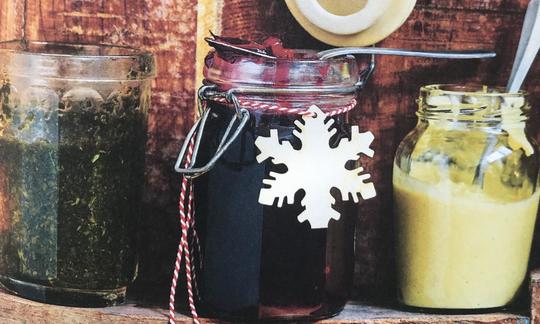Cranberry-orange sauce with apple and fresh ginger
vegan
Ingredients (for servings, )
| For the sauce | |
|---|---|
| 11 oz | Cranberries (cranberries, cranberries), raw (organic?) |
| 1 tsp | Ginger, raw (organic?) (0.07 oz) |
| 1 | Cinnamon stick (cinnamon stick, cinnamon, raw?, organic?) (0.28 oz) |
| 1 | Apple, raw, with peel (5.3 oz) |
| 7 ⅓ oz | Sugar (granulated sugar, sucrose, saccharose) |
| 240 ml | Orange juice (raw?, organic?) (8.8 oz) |
Equipment
- grater
- stove
- citrus juicer (lemon squeezer)
- saucepan
- canning jar (Weck jar, Mason jar)
Type of preparation
- cook
- chop or grind
- sauté
- squeeze
- peel
- grate (shred)
Preparation
Sterilizing jars
To sterilize the jars, place them in a large pot and fill the pot with water so that the jars are completely covered. Bring to a boil over medium heat and simmer for 3 minutes, then turn off the heat. Carefully remove the jars from the water when you are ready to fill them.For the sauce
Wash the cranberries, peel and grate the ginger. Grate the apple (preferably Braeburn variety). If possible, squeeze fresh orange juice.Mix all the ingredients for the sauce in a heavy-bottomed saucepan and heat over a low heat. Cover and simmer gently for 15 minutes, stirring occasionally.
We generally recommend keeping the sugar content as low as possible. It is therefore advisable to start with a lower amount of sugar and increase it as needed up to the specified value.
filling the sauce
Lift the jars out of the hot water (e.g. with the grill tongs), fill them up to the rim with the sauce and seal.
The sauce will last up to 4 weeks in the refrigerator.Serving size: The indicated amount makes approximately 360 g of cranberry-orange sauce. This is enough for a dish for 10 people.
|
Nutritional Information per person
Convert per 100g
|
2000 kcal | |
|---|---|---|
| Energy | 112 kcal | 5.6% |
| Fat/Lipids | 0.13 g | 0.2% |
| Saturated Fats | 0.02 g | 0.1% |
| Carbohydrates (inc.dietary fiber) | 29 g | 10.7% |
| Sugars | 25 g | 27.7% |
| Fiber | 1.9 g | 7.7% |
| Protein/Albumin | 0.39 g | 0.8% |
| Cooking Salt (Na:1.3 mg) | 3.3 mg | 0.1% |
| Essential micronutrients with the highest proportions | per person | 2000 kcal | |
|---|---|---|---|
| Vit | Vitamin C (ascorbic acid) | 18 mg | 22.0% |
| Min | Manganese, Mn | 0.23 mg | 12.0% |
| Elem | Potassium, K | 95 mg | 5.0% |
| Min | Copper, Cu | 0.04 mg | 4.0% |
| Vit | Vitamin E, as a-TEs | 0.45 mg | 4.0% |
| Vit | Vitamin B9, B11 (Folate, as the active form of folic acid) | 8.4 µg | 4.0% |
| Vit | Vitamin B1 (Thiamine) | 0.03 mg | 3.0% |
| Vit | Vitamin B6 (pyridoxine) | 0.04 mg | 3.0% |
| Vit | Vitamin K | 2.1 µg | 3.0% |
| Elem | Calcium, Ca | 14 mg | 2.0% |
Detailed Nutritional Information per Person for this Recipe
The majority of the nutritional information comes from the USDA (US Department of Agriculture). This means that the information for natural products is often incomplete or only given within broader categories, whereas in most cases products made from these have more complete information displayed.
If we take flaxseed, for example, the important essential amino acid ALA (omega-3) is only included in an overarching category whereas for flaxseed oil ALA is listed specifically. In time, we will be able to change this, but it will require a lot of work. An “i” appears behind ingredients that have been adjusted and an explanation appears when you hover over this symbol.
For Erb Muesli, the original calculations resulted in 48 % of the daily requirement of ALA — but with the correction, we see that the muesli actually covers >100 % of the necessary recommendation for the omega-3 fatty acid ALA. Our goal is to eventually be able to compare the nutritional value of our recipes with those that are used in conventional western lifestyles.
| Essential fatty acids | per person | 2000 kcal |
|---|---|---|
| Alpha-Linolenic acid; ALA; 18:3 omega-3 | 0.01 g | 1.0% |
| Linoleic acid; LA; 18:2 omega-6 | 0.02 g | < 0.1% |
| Essential amino acids | per person | 2000 kcal |
|---|---|---|
| Tryptophan (Trp, W) | 0.00 g | 1.0% |
| Threonine (Thr, T, irreversibly transaminated) | 0.01 g | 1.0% |
| Isoleucine (Ile, I) | 0.01 g | 1.0% |
| Leucine (Leu, L) | 0.02 g | 1.0% |
| Lysine (Lys, K, irreversibly transaminated) | 0.02 g | 1.0% |
| Phenylalanine (Phe, F) | 0.02 g | 1.0% |
| Valin (Val, V) | 0.02 g | 1.0% |
| Methionine (Met, M) | 0.00 g | < 0.1% |
| Vitamins | per person | 2000 kcal |
|---|---|---|
| Vitamin C (ascorbic acid) | 18 mg | 22.0% |
| Vitamin E, as a-TEs | 0.45 mg | 4.0% |
| Vitamin B9, B11 (Folate, as the active form of folic acid) | 8.4 µg | 4.0% |
| Vitamin B1 (Thiamine) | 0.03 mg | 3.0% |
| Vitamin B6 (pyridoxine) | 0.04 mg | 3.0% |
| Vitamin K | 2.1 µg | 3.0% |
| Vitamin B2 (Riboflavin) | 0.02 mg | 2.0% |
| Vitamin B5 (Pantothenic acid) | 0.15 mg | 2.0% |
| Vitamin B7 (Biotin, ex vitamin H) | 0.75 µg | 2.0% |
| Vitamin B3 (Niacin) | 0.16 mg | 1.0% |
| Vitamin A, as RAE | 4.0 µg | < 0.1% |
| Essential macroelements (macronutrients) | per person | 2000 kcal |
|---|---|---|
| Potassium, K | 95 mg | 5.0% |
| Calcium, Ca | 14 mg | 2.0% |
| Magnesium, Mg | 5.9 mg | 2.0% |
| Phosphorus, P | 9.8 mg | 1.0% |
| Sodium, Na | 1.3 mg | < 0.1% |
| Essential trace elements (micronutrients) | per person | 2000 kcal |
|---|---|---|
| Manganese, Mn | 0.23 mg | 12.0% |
| Copper, Cu | 0.04 mg | 4.0% |
| Iron, Fe | 0.22 mg | 2.0% |
| Zinc, Zn | 0.06 mg | 1.0% |
| Fluorine, F | 0.50 µg | < 0.1% |
| Selenium, Se | 0.20 µg | < 0.1% |
| Iod, I (Jod, J) | 0.13 µg | < 0.1% |
Narayana Verlag GmbH /Unimedica Verlag , Gaz Oakley
Raw recipes 3, Cooked recipes 63 (3)
Additional photos (6)
The cookbook "Vegan Christmas - over 70 wonderful recipes for Christmas" contains a selection of classic vegan recipes.
Since this book is written in German, a description is omitted here. If you are interested, please switch to German in the menu.
The cranberry-orange sauce with apple and fresh ginger is particularly suitable for Christmas dishes.
Serving size: The indicated amount for 10 servings yields approximately 360 g of cranberry-orange sauce.
Cranberries: With their tart, sour taste, the raw bilberry (blueberry), also known as cranberry, is popular in Germany both raw and cooked. Cranberry rice is said to contain ingredients that prevent bacteria from attaching to the surface of the urinary tract. However, the effect on urinary tract infections is controversial.
Orange juice: Orange juice, also known as OJ or orange juice, has a high vitamin C content. This amounts to just over 50 mg in 100 ml, i.e. more than 50% of the recommended daily requirement according to the GDA recommendation. Orange juice is the most consumed juice in the world, with the lion's share of exports coming from Brazil.
Ginger: Ginger has an aromatic smell and a sharp and spicy taste, which is mainly due to the substance gingerol, which is said to have anti-carcinogenic and anti-inflammatory effects. The substances borneol and cineol give ginger its digestive, stomach-strengthening, antiemetic, appetite-stimulating and circulation-stimulating properties. The rhizome of ginger is used in cooking, in fresh, dried or ground form. The young harvested rhizomes are called green or young ginger. They have a much milder taste and are less woody.
Cinnamon: Cinnamon is a spice made from the dried bark of cinnamon trees. Cinnamon owes its aroma mainly to the cinnamon oil, which consists of 75 percent cinnamaldehyde. In Europe, cinnamon is used as a spice mainly for sweet dishes and drinks, but in Indian and Middle Eastern cuisine it is also often added to hearty dishes. The cheaper cassia cinnamon or Chinese cinnamon in particular contains high doses of coumarin, which is harmful to health. Since the amount of coumarin in the better Ceylon cinnamon is only about a hundredth of that, it is preferable for larger preparations.
From an ecological point of view, it is advisable to use regional organic sugar, such as beet sugar (sucrose, consisting of glucose and fructose) or grain sugar (maltose, consisting of glucose) in Germany, in order to avoid long transport routes. Grain sugar is slightly less sweet, but due to the lack of fructose it is also suitable for those who suffer from fructose intolerance.
Less sugar: We generally recommend keeping the sugar content as low as possible. It is therefore advisable to start with a lower amount of sugar and increase it as needed up to the specified amount. Please also read the following link: Vegans often eat unhealthily. Avoidable nutritional errors.




